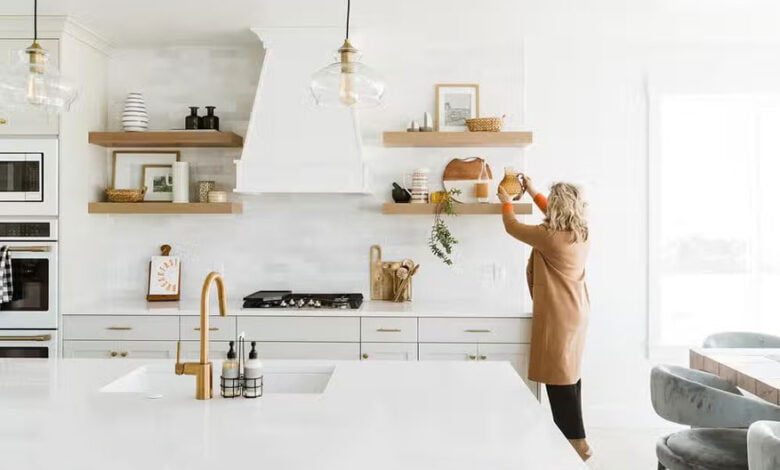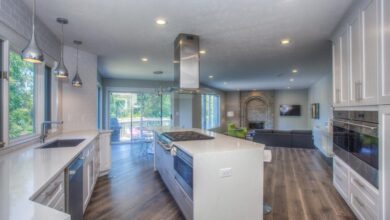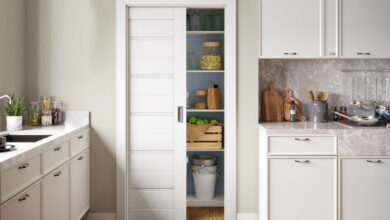How to Plan and Build Your Dream Kitchen

Creating your dream kitchen that perfectly suits your needs and lifestyle requires careful planning, expert help, and seamless project execution. The design-build approach streamlines the process by working with a single firm that handles both the design and construction.
This comprehensive guide will walk you through the key steps of successfully building your ideal kitchen.
Introduction
A well-designed kitchen forms the heart of a home. More than just a place to cook meals, it is often where family and friends gather to bond. The layout, amenities, lighting, and aesthetic touches you incorporate impact how well this space performs for years to come.
The design-build methodology offers home remodeling project owners an efficient path to turn their vision into reality. Instead of hiring a designer and contractor separately, you work with a unified team providing both services. This facilitates better collaboration and accountability.
This guide will illustrate what it takes to design and build out your perfect kitchen. From initial planning to final touches, you’ll know what to consider at every stage working with a design-build firm. Let’s begin the exciting journey!
Planning Your Ideal Kitchen
The key to a kitchen remodel that fulfills your wish list is meticulous planning before involving any professionals. Ask yourself the hard questions upfront to develop a practical scope aligned with your budget.
Assessing Your Needs and Lifestyle
How you plan on using your kitchen should significantly influence the layout and features. Will you regularly host large dinner parties or often cook complex meals? Are multiple people doing extensive baking or homework?
Analyze how your family currently functions in this space. How can the new design better provide convenience and comfort based on your routines?
Create a prioritized list outlining must-haves along with nice-to-have elements. This keeps your vision grounded in reality. Remember to consider not only cooking needs but spaces for dining, relaxation, and entertainment.
Setting a Realistic Budget
Underestimating project costs is one of the biggest mistakes kitchen remodelers make. Before meeting with a design-build firm, research average local rates for different types of kitchens. Get an idea of pricing for the cabinetry types, appliances, surfaces, lighting, and layout complexity you desire.
Add contingencies of 10-20% to account for unforeseen issues popping up mid-project. If your budget won’t support everything on your wish list, determine what you’re willing to sacrifice or phase in later.
Researching Design Styles and Trends
Part of the fun is deciding what architectural style reflects your aesthetic. Classic choices like farmhouse and contemporary remain ever popular. But open your eyes to new directions like modern minimalism or retro industrial.
Think through what mood you want to achieve and how important staying on trend is. Glean inspiration from sites like Pinterest but avoid wholesale copying. Your kitchen should showcase your unique flair.
Hiring the Right Professionals
A design-build firm combines kitchen designers and licensed contractors under one umbrella. This unified team structure facilitates better collaboration to handle projects smoothly from concept to completion.
Understanding the Role of Design-Build Firms
These specialists manage your kitchen remodel seamlessly by overseeing both the design development and physical construction. Instead of trying to coordinate two separate entities, you have a central point of contact.
Experienced designers on staff translate your vision for workflow, storage solutions, and ambiance into a physical layout. Their understanding of construction logistics enables creating buildable plans.
The contractors then execute the project based on these documents. With staff designers and builders working closely together, there is clearer communication and accountability.
Selecting a Reputable Contractor
Checking references is mandatory before hiring any kitchen design-build firm. Ask family and friends for referrals to reliable companies they’ve personally worked with.
Verify credentials for all architects, designers, and contractors. Ensure the company and individuals maintain proper licensing and insurance.
Review online testimonials and check ratings with organizations like the Better Business Bureau. Top ratings for quality, timely performance, responsiveness, and transparency are reassuring signs.
Working with an Experienced Designer
The lead designer helps translate your style preferences, cooking habits, storage needs, and functional wishes into a physical plan. Opt for someone well-versed across many kitchen projects spanning different scales and budgets.
Verify their credentials and mastery over critical elements like lighting design, space planning, cabinetry design, appliance selection, and materials choices. Great listening skills and clear communication ability ensure the back-and-forth design process goes smoothly.
Designing Your Dream Kitchen
With the right design-build team assembled, now begins the creative process for your ideal layout, features, and style details.
Creating a Functional Layout
An efficient floor plan aligns storage, appliances, counters, and work triangles to your habits. Think through where you perform which tasks and how multiple cooks maneuver. Heighten convenience through clever organization hacks like pull-out pantries.
Don’t neglect ergonomics and ease-of-use either. Position frequently used items in the prime zone to avoid excessive reaching or bending. Accommodate varying user heights through adjustable components.
Choosing High-Quality Materials and Finishes
Durable, low-maintenance materials prevent yellowing, warping, erosion, and scratches over decades of use. Research appearance, texture, durability, and ease of cleaning before picking surfaces.
Uphold aesthetic coherence through finishes speaking the same design language. For ornate traditional styling, select distressed wood beams, painted cabinets, and marble counters. Stainless steel, glass tiles, and sleek handles suit contemporary kitchens.
Incorporating Smart Storage Solutions
Maximize every inch through customized cabinets and clever built-ins fitting your specific serveware and appliances. Consider pull-out shelves, angled corners, tray dividers, and hidden nooks.
If hosting large gatherings, ensure adequate space for food prep and presentation. A walk-in pantry provides overflow capacity. Plan charging stations for convenient device rejuicing.
Navigating the Permitting and Approval Process
Before construction commences, the project must pass several local government inspections aligned with building codes and zoning laws.
Understanding Local Building Codes
Municipalities provide guidance on which project elements require permitting/approval before work occurs. For example, many regions mandate permits for structural changes, electrical/plumbing work, cabinetry additions, and layout modifications.
Design-build firms keep current on the latest codes and typically handle securing necessary sign-offs. Still, homeowners should review their jurisdiction’s kitchen remodeling guidelines.
Securing Necessary Permits and Approvals
To obtain permits, companies submit project documentation like floor plans, equipment specs, materials chosen, zoning data, and construction schedules to regulators. Once approved, work gets authorized to begin per those exact plans.
Timelines vary greatly by region from days to months. Utilize an experienced local contractor familiar with navigating your area’s bureaucracy efficiently. They forecast reasonable approval windows within the project plan.
Ensuring Compliance with Regulations
With permits secured, builders must uphold all construction codes and inspection requirements. For example, eco-mandates govern the safe removal and disposal of components like old cabinets or lead-painted walls.
Development of “as-built” drawings depicting completed work proves adherence. The design-build firm also photographs critical project milestones as proof for regulators. Welcome these measures as protecting your health and safety.
The Construction Phase
The tear out and building process typically represents the dustiest and most disruptive phase. But with a detailed schedule and quality team, it proceeds relatively smoothly.
Preparing for Demolition and Site Preparation
Crews first mobilize equipment, materials, protective sheeting, and temporary power sources and water access. Next comes clearing out old cabinets, flooring, and appliances to simplify installation.
Proper protective measures like drop cloths and temporary walls contain dust infiltration elsewhere. Dumpsters conveniently remove heavy debris. The team relocates utilities like plumbing and electrical behind new walls before framing.
Managing the Construction Timeline
Complex projects easily get delayed when various specialists don’t coordinate well across long sequences. That’s why seasoned design-build firms invest heavily in project management.
Software tools track appliance delivery statuses, subcontractor schedules, and materials orders on one master calendar. Daily crew meetings enable identifying potential bottlenecks before crises erupt. Such vigilance contained pesky surprises.
Overseeing Quality Control and Inspections
While the design-build firm directs daily construction operations, you should still monitor progress and ask questions. Is work meeting outlined specifications and aesthetics? Are safety protocols being followed consistently?
Validating compliance with codes via rigorous inspections prevents issues down the road. Review installed fire alarms, extinguishers, anti-tip brackets, GFCI electrical outlets, and ventilation effectiveness. Consider paying for third-party inspections for greater impartiality.
Selecting Appliances and Fixtures
The appliances and fixtures you select dictate both function and form within your new kitchen for years ahead. Keep long-term reliability, efficiency, and resale value in mind.
Evaluating Energy-Efficient Options
Minimize energy and water expenditures through ENERGY STAR-rated appliances offering smarter resource use without compromising performance. Compare ratings across brands noting differences to prioritize.
Research rebates offered in your region to defray higher smart appliance costs. Take advantage of tax incentives for qualifying eco-upgrades like tankless water heaters and induction cooktops too.
Incorporating Smart Home Technology
Today’s appliance advancements enable extensive voice-assisted, app-based control for greater convenience and precision. Test out options like refrigerators with cameras allowing remote peeks inside or automated temperature and lighting adjustments when not home.
Ensure your design-build team properly provisions the electrical, networking, and wiring components needed behind the scenes. Also confirm all devices and modules play nicely together through a central smart home platform.
Ensuring Seamless Integration with the Design
Avoid stylistic mismatches detracting from your kitchen’s cohesiveness. Analyze appliance finishes, dimensions, positions for optimal sightlines and ergonomics. Double check window placements don’t conflict with refrigerator doors and handles clearing cabinet edges.
Frame induction cooktops, range hood inserts, and slim dishwashers flush within cabinetry for a sleek assembled look. Hide everyday clutter in slide-out cabinet racks, Lazy Susans, and pull-out trash/recycling receptacles.
Adding Personal Touches and Final Details
With the cabinetry, lighting, walls, and floors installed, the opportunity emerges to infuse decorative flair showcasing your unique personality.
Customizing Your Kitchen with Unique Features
Dream up special details setting your kitchen apart. Display your prized ceramic dish collection within glass door cabinets bathed under accent lighting. Cozy banquette breakfast nooks promote lingering over Sunday paper perusing and coffee.
Selecting Lighting and Decor Elements
The fixtures and accents incorporated dictate the room’s overall mood from soft and romantic to vibrant and sleek. Incorporate varied lighting layers ranging from statement chandeliers to decorative undercabinet ropes to task lighting keeping prep zones brightly illuminated.
Flaunt style through mixing metal finishes, playful wallpaper, textured tile backsplashes, or glass mosaics. Remember lighting and shelving enables rotating beloved mementos seasonally.
Ensuring a Cohesive and Inviting Atmosphere
Preserve stylistic harmony across all surfaces and zones in both form and function. Uphold sufficient clearance between pieces for unencumbered circulation and cleaning access behind.
Use cohesive paint colors, textures, materials, and decorative touches to unify the look. Infuse warmth through touches like fresh flowers, fruit bowls, herb planters, and framed photos.
Ensuring Long-Term Functionality and Maintenance
Sweat details during the design phase to enhance ongoing convenience while simplifying cleaning and repairs.
Implementing Easy-to-Clean Surfaces and Materials
High-traffic kitchens show grime fast, especially with little kids underfoot. Select durable, non-porous materials like quartz counters over grout-happy tiles. Opt for scratch-resistant finishes that wipe free of grease and food debris easily without harsh chemicals.
Strategically place hardwater fixtures away from appliances prone to calcification like coffeemakers. Gather everyday clutter out of sight through enclosed cabinets rather than exposed shelving.
Understanding Warranty and Maintenance Requirements
Review all warranty documentation to understand limitations and required upkeep. For example, soapstone counters demand regular oiling and granite resealing. Improper cleaning voids certain solid surface material and flooring warranties.
Catalog appliance manuals detailing filter replacement timetables, descaling procedures, normal wear parts, and warranty claim processes. Set calendar reminders so you don’t lose coverage over lack of preventative maintenance.
Tips for Preserving the Beauty of Your New Kitchen
Guard your investment through smart daily habits like cleaning spills quickly, using cutting boards, opening windows during cooking, wiping appliance exteriors, and vetting household cleaners before use.
Consider protective options like waterproof flooring in high-moisture zones, gel pads under appliances, cabinet door bumpers, and slip-resistant rug backings. Welcome visitors by offering trivets and coasters too!
Conclusion
Completing a kitchen redesign ranks among the most intense yet rewarding home improvement journeys. By conveying your vision while closely collaborating with the design-build experts, the finished masterpiece nourishes your family for decades.
Celebrating the Completion of Your Ideal Kitchen
That first home-cooked meal enjoyed together in the redesigned heart of your home marks a special milestone. Bask in this newfound feeling of spaciousness, organization, and stylishness upgraded through the team’s creativity and workmanship.
Host a fun open house for friends and neighbors to show off gorgeous photos documenting the transformation from initial demolition mess to completed oasis. Share lessons learned and resources that helped your project go smoothly to pay it forward.
Reflecting on the Design-Build Journey
Each kitchen project journey tells a unique story filled with learning, laughter, and memories made over many months working alongside the design and construction crew. Expect a rollercoaster ride filled with both triumphs and setbacks before the ribbon finally gets cut.
Pride and deep satisfaction comes from overcoming obstacles as a team. Gain confidence in trusting your instincts when making critical choices balancing aesthetics and functionality. Carry these insights forward into future remodeling endeavors.
Looking Forward to Enjoying Your New Space
While everyone obsesses over “before and after” photos, what truly matters is the joy this kitchen facilitates every single day. Savor teaching your kids baking basics at the expansive center island. Laugh wholeheartedly during spontaneous dance parties facilitated by awesome acoustics. Host effortless dinner parties thanks to serious prep and storage capacity.
This heart of your home distinctly reflects who you are while accommodating how you aspire to live for years ahead. May this thoughtfully designed and crafted space serve your family exceptionally well!




